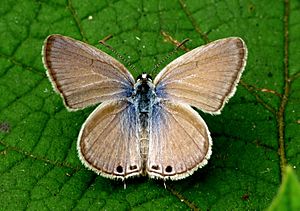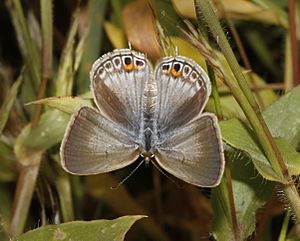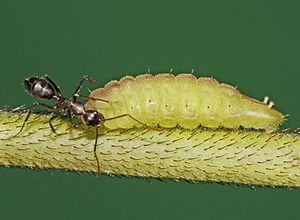Gram blue facts for kids
Quick facts for kids Gram blue |
|
|---|---|
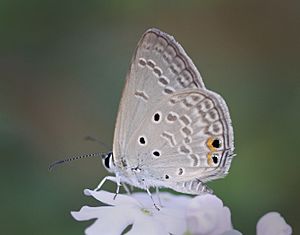 |
|
| Male | |
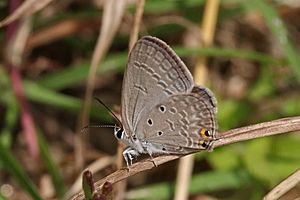 |
|
| Female | |
| Scientific classification | |
| Kingdom: | |
| Phylum: | |
| Class: | |
| Order: | |
| Family: | |
| Tribe: |
Polyommatini
|
| Genus: |
Euchrysops
|
| Species: |
E. cnejus
|
| Binomial name | |
| Euchrysops cnejus (Fabricius 1798)
|
|
| Synonyms | |
|
|
The gram blue (scientific name: Euchrysops cnejus) is a small, beautiful butterfly. It belongs to the Lycaenidae family, which are often called "blues" because of their color. You can find this butterfly in many places, from India all the way to Australia. A scientist named Johan Christian Fabricius first described this species in 1798.
Contents
What Does the Gram Blue Look Like?
The male gram blue butterfly has wings that are a pale purplish color, sometimes looking bluish in certain light. The front wings have a thin black line along the edge. The back wings have two small black spots near the bottom edge. These spots have a white outline and a bit of orange color inside. The edges of both wings have light-colored hairs, called cilia. The back wings also have a tiny black "tail" tipped with white.
The underside of the male's wings is a shiny silver-grey, sometimes with a hint of yellow or brown. Both the front and back wings have brown spots with thin white edges. There are also several lines of spots, some straight and some wavy. The back wings have a few more white-edged spots near the body, with one being a clear black spot.
The female gram blue butterfly has dark brown upper wings. Her front wings have a blue area near the body, and a thin black line along the edge. Her back wings are also slightly blue near the body. They have a line of white, arrow-shaped spots, followed by a line of round spots. The last two spots near the bottom are jet-black and larger, with bright orange and thin white lines around them. The edges of the female's wings have very noticeable white hairs.
The underside of the female's wings looks similar to the male's. The two black spots on her back wings have a touch of shiny bluish-green. Both male and female butterflies have dark brown antennae, head, and body, with white speckles on the antennae.
Where Does the Gram Blue Live?
This butterfly is found across most of India, though not in very high mountains. It is also common in the Malayan region and spreads out to Australia and the South Sea Islands.
The Caterpillar Stage (Larva)
The gram blue caterpillar, also known as a larva, has a typical shape for butterflies in its family. Its head is small, black, and shiny, and it can pull its head inside its body. The caterpillar's body is pale green, with darker green or reddish lines along its back. Its whole body is covered with tiny white bumps and a few scattered white hairs.
The caterpillar's body gets wider towards the front and then stays about the same width until its flattened end. These caterpillars like to eat plants. They have been seen feeding on plants like Phaseolus trilobus and Dolichos catjang. Sometimes, ants like the Camponotus rubripes subspecies compressus are found near these caterpillars.
The Pupa Stage
The pupa is the stage after the caterpillar and before the butterfly. The gram blue pupa is a very pale green color. It has the usual shape for a butterfly pupa, without any special bumps or markings. The head area is somewhat square, and the body has a slight hump. There is a dark line running along its back. The entire surface of the pupa is smooth and not hairy.
Different Types of Gram Blue
There are a few different types, or subspecies, of the gram blue butterfly found in various parts of the world:
- E. c. cnejus
- E. c. cnidus Waterhouse & Lyell, 1914 (Found in places like the Torres Strait Islands, northern Australia, New Guinea, and the Solomon Islands)
- E. c. vitiensis (Butler, 1883) (Found in Fiji)
- E. c. luzonicus (Röber, 1886) (Found in the Philippines, including Palawan, Cebu, Leyte, Luzon, and Tawitawi)


